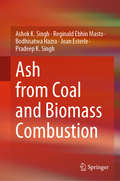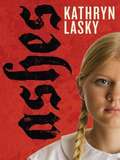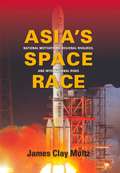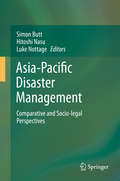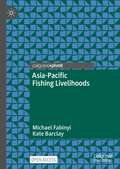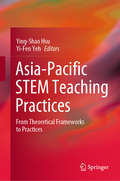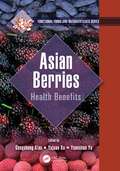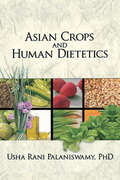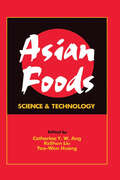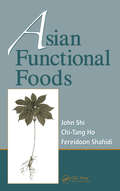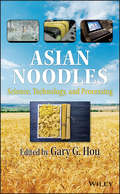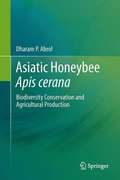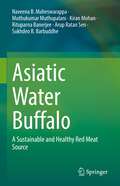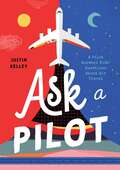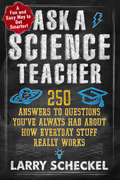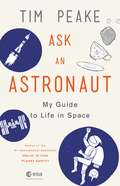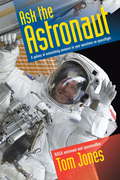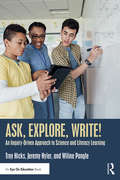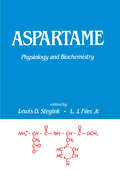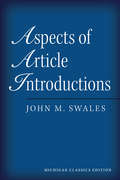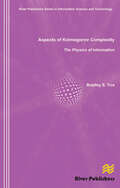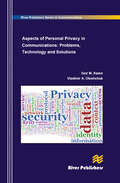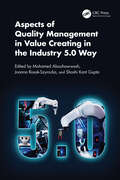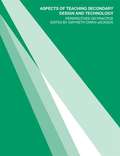- Table View
- List View
Ash from Coal and Biomass Combustion
by Bodhisatwa Hazra Pradeep K. Singh Ashok K. Singh Reginald Ebhin Masto Joan EsterleThis is a concise book with comprehensive information on coal and biomass ash generated from their combustion in thermal power plants. It presents detailed studies on ash generated from contrasting coal and biomass feedstocks, and provides a comparative evaluation of these different ashes in terms of their origin, properties, environmental hazards. Potential utilizations with specific advantages and disadvantages of the respective ashes are elaborated in detail, including some innovative means of ash utilization for value addition purposes. By addressing both the theory and commercial exploitation of these products, this book will be helpful for industrialists, academicians and researchers alike.
Ashes
by Kathryn LaskyBerlin, 1932. Thirteen-year-old Gabriella Schramm's world is slowly, but steadily, crumbling as Adolf Hitler rises to power. <P><P>The only thing that soothes Gabriella is her favorite pastime-reading. <P><P>But then her country's tensions rise, the streets fill with soldiers, Gaby's sister's boyfriend raises his arm in a heil Hitler salute, and a family friend-Albert Einstein-flees the country. <P><P>And her only solace-her books-come under attack. Will Gaby have to leave behind the stories-and the life-that she has always loved?
Asia's Space Race: National Motivations, Regional Rivalries, and International Risks (Contemporary Asia in the World)
by James Clay MoltzIn contrast to the close cooperation practiced among European states, space relations among Asian states have become increasingly tense. If current trends continue, the Asian civilian space competition could become a military race. To better understand these emerging dynamics, James Clay Moltz conducts the first in-depth policy analysis of Asia's fourteen leading space programs, concentrating especially on developments in China, Japan, India, and South Korea. <P><P>Moltz isolates the domestic motivations driving Asia's space actors, revisiting critical events such as China's 2007 antisatellite weapons test and manned flights, Japan's successful Kaguya lunar mission and Kibo module for the International Space Station (ISS), India's Chandrayaan lunar mission, and South Korea's astronaut visit to the ISS, along with plans to establish independent space-launch capability. He investigates these nations' divergent space goals and their tendency to focus on national solutions and self-reliance rather than regionwide cooperation and multilateral initiatives. He concludes with recommendations for improved intra-Asian space cooperation and regional conflict prevention.Moltz also considers America's efforts to engage Asia's space programs in joint activities and the prospects for future U.S. space leadership. He extends his analysis to the relationship between space programs and economic development in Australia, Indonesia, Malaysia, North Korea, Pakistan, the Philippines, Singapore, Taiwan, Thailand, and Vietnam, making this a key text for international relations and Asian studies scholars.
Asia-Pacific Disaster Management: Comparative and Socio-legal Perspectives
by Luke Nottage Hitoshi Nasu Simon ButtThe book outlines the regulatory environment for disaster prevention and management in broad social, economic and political context. The first half of the book focuses mainly on Japan, especially the '3-11' events: the earthquake and tsunami that devastated the Tohoku area on 11 March 2011 and the Fukushima Daiichi nuclear power plant radiation leaks. The second half focuses on the USA (the only other Asia-Pacific country to have experienced a serious nuclear emergency), Indonesia, China, New Zealand, Australia and international law. One question explored is whether socio-legal norms play different roles in preventing and managing responses to natural disasters compared to 'man-made' disasters. Another is how 'disaster law' interacts with society across very diverse societies in the disaster-prone Asia-Pacific region. The book also addresses the increasingly important roles played by international law and regional regimes for cross-border cooperation in disaster prevention and relief, including the functions played by military forces. Erudite, pragmatic, and charged with detailed, substantive knowledge of an astonishing range of contexts and research fields, this timely collection of important essays on the law and society of disaster management stands as an exemplary international academic response to the disasters of 11 March 2011. (Annelise Riles)
Asia-Pacific Fishing Livelihoods
by Kate Barclay Michael FabinyiThis open access book explores fishing livelihoods in the context of the wider contexts in which they are embedded. Drawing on case studies from across the Asia-Pacific region, the book highlights how fishing livelihoods are shaped by globalisation, social relationships and governance. The book concludes by showing how better understanding these relationships can contribute to governance for healthier ecosystems and social wellbeing.This is an open access book.This is an open access book.
Asia-Pacific STEM Teaching Practices: From Theoretical Frameworks to Practices
by Ying-Shao Hsu Yi-Fen YehThis book offers various perspectives on the complex and crosscutting concepts of the science, technology, engineering, and mathematics (STEM) disciplines in the classroom context. Presenting empirical studies, it reveals how researchers in the Asia-Pacific Region planned and implemented STEM education in the classroom. Further, it discusses the assessment of STEM learning to clarify what important elements should be included and how researchers and educators frame and design assessment tools. The book consists of four parts: potential and trends in STEM education; teachers’ practical knowledge for STEM teaching; STEM teaching practices; and assessment of STEM learning. Providing evidence on developing curriculums, implementing instructional practices and educating classroom teachers, it is intended for readers wanting to explore STEM education from multiple perspectives.
Asian Berries: Health Benefits (Functional Foods and Nutraceuticals)
by Gengsheng Xiao Yujuan Xu Yuanshan YuAs consumers look to natural foods to promote health and well-being, their focus has been on foods with recognized health properties. Natural health products with rich antioxidant and high free radical scavenging activity such as Asian berries currently draw the interest of scientific researchers, whose goal is to evaluate Asian berries’ nutritional and health-promoting properties. Collected in one source, Asian Berries: Health Benefits covers a wide array of different Asian berries, their properties, potential health benefits, and possible uses. Asian berries are well-known traditional nutritional foods and herbal medicinals as well as valuable nourishing tonic, which has been used for thousands of years in Asian countries. They are traditionally employed as herbal medicinals from ancient times. Recently, Asian berries widely marketed as health foods have become increasingly popular in the Western world because of their health-promoting properties. This book explores a wide array of possibilities and benefits that come from Asian berries. Key Features: Defines chemical, biochemical properties, bioactive components and health benefits of Asian berries Details postharvest storage technology and processing technology development Explains utilization of Asian berries by-products Discusses Asian berries functional foods as well as food safety issues Complete with 18 chapters written by experts in their field, Asian Berries: Health Benefits serves as an excellent reference for anyone interested in the science and technology of bioactive components from Asian berries as health-promoting foods.
Asian Crops and Human Dietetics
by Usha R. PalaniswamyGo beyond the nutritional value to discover the lesser known health benefits of certain Asian crops Several foods from the Asian culture that are not well known to other parts of the world have health benefits that stretch beyond mere nutritional value. Asian Crops and Human Dietetics comprehensively reviews the plants and spices in the A
Asian Foods: Science and Technology
by KeShun Liu Catharina Y. W. Ang Yao-Wen HuangThis comprehensive new book provides up-to-date information on many types of Asian prepared foods-their origin, preparation methods, processing principles, technical innovation, quality factors, nutritional values, and market potential. Written by experts who specialize in the field, it includes information on Asian dietary habits and the health si
Asian Functional Foods
by Fereidoon Shahidi John Shi Chi-Tang HoThe consumption of functional foods has emerged as a major consumer-driven trend, based on the needs of an ever-growing health conscious population that wants to exercise greater control over its health. Focusing on an important sector of this rapidly growing field, Asian Functional Foods discusses the theoretical and practical aspects of functiona
Asian Noodles
by Gary G. HouIn Asian Noodles: Science, Technology and Processing, international experts review the current knowledge and offer comprehensive cutting-edge coverage on Asian noodles unmatchable in any publication. The authors cover an array of topics including breeding for noodle wheat, noodle flour milling, noodle flour quality control and analysis, noodle processing, sensory and instrumental measurements of noodle quality, the effects of wheat factors on noodle quality, packaging and storage, nutritional fortification of noodle products, noodle flavor seasoning, and noodle plant setup and management.
Asian Space Race: Rhetoric Or Reality?
by Ajey LeleThis book explores the character and contours of the Asian Space Powers. At present, Asian states like China, Japan and India are found investing in space technologies with analogous social and scientific and probably with divergent military intents. Other Asian states like Israel, South Korea and Malaysia are also making investments in the space arena. States like Iran and North Korea are faulted for using space launches as a demonstrative tool to achieve strategic objectives. This work examines this entire maze of activities to unearth where these states are making these investments to accomplish their state-specific goal or are they also trying to surpass each other by engaging in competition. Explaining why and how these states are making investments towards achieving their socio-economic and strategic mandate this book infers that the possibility of Asian Space Race exists but is presently fairly diminutive.
Asiatic Honeybee Apis cerana: Biodiversity Conservation and Agricultural Production
by Dharam P. AbrolDespite its economic usefulness, biodiversity of Asian hive bee Apis cerana is suffering precipitous decline and is threatened with extinction in its entire native habitat. Although a number of publications have appeared on honeybees in the market no attempt has been made to approach the subject in systematically and in a comprehensive manner in case of Apis cerana. There is still not enough knowledge on different facets of biological conservation, agricultural production and role in improving food security and livelihoods. An attempt has been made in this book to fill the gap by providing detailed information on different aspects of Apis cerana leading to sustainability and environmental protection. This book discusses information on varied aspects of Apis cerana biology, biogeography, reproduction, genetics, molecular phylogeny, interaction with other species, floral resources, dance language, safety from pesticides, management problems, loss of genetic diversity, behavioural defence, role in food production, livelihood security and conservation strategies for protecting biodiversity and enhancing crop productivity. The compilation of this book is unique in the sense that in the context of pollinator decline over the world, conservation of this species will be a step for sustaining food security.
Asiatic Water Buffalo: A Sustainable and Healthy Red Meat Source
by Rituparna Banerjee Naveena B. Maheswarappa Muthukumar Muthupalani Kiran Mohan Arup Ratan Sen Sukhdeo B. BarbuddheThis need-based unique book deals exclusively with water buffalo (Bubalus bubalis) meat to provide much needed information to thousands of buffalo meat processors across the world. The information provided in this first-of-its-kind book on buffalo meat quality, nutritional characteristics, safety, and processing can be utilized by buffalo meat producers and meat processors for the advancement of the buffalo meat sector. It also provides valuable information to faculty members, students, researchers, and all other readers interested in this new source of meat. Owing to the limited research and scientific literature available on buffalo meat, the authors’ own research findings and our experiences were included wherever required to give crisp, practical, and complete information. The information proposed in this book should be beneficial to the entire buffalo industry, from the farming and processing of buffaloes to the marketing of products. This serve as a handy guide to meat scientists, faculty members, and students willing to learn more about buffalo meat processing. Up-to-date relevant references were also included for the benefit of researchers and students to enable them to easily access further information. Above all, it provides valuable information to consumers who are interested to know this new and potential source of meat.
Ask a Pilot
by Justin KelleyAuthor, pilot, and dad Justin Kelley puts kids at ease by answering twenty of their most pressing questions. Flying is fascinating, and kids have questions! Why don't planes hit each other in the sky? Do you start a plane with a key? Why do my ears feel funny? With friendly language, simple explanations, and colorful illustrations, Ask a Pilot is the perfect handbook for aviation lovers and nervous flyers alike! From the Introduction: Do you dream of flying? If you answered yes, then this book is for you. On the other hand, if you answered no, and you started to sweat a little, and your heart started racing because the thought of trusting a huge, metal airplane that stays in the air by some unknown magic terrifies you, well . . . this book is also for you. Especially for you. In this book, you’ll find answers to real questions from real kids. Some are funny, some are serious, but all of them have real answers to help make flying a little less mysterious.
Ask a Science Teacher: 250 Answers to Questions You've Always Had About How Everyday Stuff Really Works
by Larry ScheckelFun and fascinating science is everywhere, and it’s a cinch to learn—just ask a science teacher! We’ve all grown so used to living in a world filled with wonders that we sometimes forget to wonder about them: What creates the wind? Do fish sleep? Why do we blink? These are common phenomena, but it’s a rare person who really knows the answers—do you? All too often, the explanations remain shrouded in mystery—or behind a haze of technical language. For those of us who should have raised our hands in science class but didn’t, Larry Scheckel comes to the rescue. An award-winning science teacher and longtime columnist for his local newspaper, Scheckel is a master explainer with a trove of knowledge. Just ask the students and devoted readers who have spent years trying to stump him! In Ask a Science Teacher, Scheckel collects 250 of his favorite Q&As. Like the best teachers, he writes so that kids can understand, but he doesn’t water things down— he’ll satisfy even the most inquisitive minds. Topics include:•The Human Body •Earth Science •Astronomy •Chemistry Physics •Technology •Zoology •Music and conundrums that don’t fit into any category With refreshingly uncomplicated explanations, Ask a Science Teacher is sure to resolve the everyday mysteries you’ve always wondered about. You’ll learn how planes really fly, why the Earth is round, how microwaves heat food, and much more—before you know it, all your friends will be asking you!
Ask an Astronaut: My Guide To Life In Space
by Tim PeakeWas it fun to do a space walk? How squashed were you in the capsule on the way back? What were your feelings as you looked down on Earth for the first time? Were you ever scared? Where to next--the Moon, Mars, or beyond?Based on his historic mission to the International Space Station, Ask an Astronaut is Tim Peake's guide to life in space, and his answers to the thousands of questions he has been asked since his return to Earth. With explanations ranging from the mundane--how do you wash your clothes or go to the bathroom while in orbit?--to the profound--what's the point?--all written in Tim's characteristically warm style, Tim shares his thoughts on every aspect of space exploration. From training for the mission to launch, to his historic spacewalk, to re-entry, he reveals for readers of all ages the cutting-edge science behind his groundbreaking experiments, and the wonders of daily life on board the International Space Station. The public was invited to submit questions using the hashtag #askanastronaut, and a selection are answered by Tim in the book, accompanied with illustrations, diagrams, and never-before-seen photos.
Ask the Astronaut: A Galaxy of Astonishing Answers to Your Questions on Spaceflight
by Tom JonesEver wondered what space is really like? Thanks to his 25 years of training for, flying in, consulting on, and writing and speaking about space, astronaut and spacewalker Tom Jones can answer that question and many others. What do you feel on liftoff? What is weightlessness? Where do you sleep in space? Can you see the Great Wall of China? Jones answers every question you have ever had about space in Ask the Astronaut. His entertaining blend of wit, personal experience, and technical expertise shines in each answer, and together all the answers illuminate the true space experience from start to finish. His engaging and informative responses remind readers of historic space achievements, acquaint them with exciting new ambitions, make them feel like they have experienced space firsthand, and even inspire an urge to explore space themselves. Jones covers everything from the training process for new astronaut candidates and the physical sensations and challenges of rocketing into orbit to what it's like to live, work, and walk in space. Jones also explores the future of spaceflight, both professional and commercial, in the years to come. Ask the Astronaut is a delight for all readers, especially "armchair astronauts" and younger, 21st century space explorers.
Ask, Explore, Write!: An Inquiry-Driven Approach to Science and Literacy Learning
by Troy Hicks Jeremy Hyler Wiline PangleDiscover how to effectively incorporate literacy instruction into your middle or high school science classroom with this practical book. You’ll find creative, inquiry-based tools to show you what it means to teach science with and through writing, and strategies to help your students become young scientists who can use reading and writing to better understand their world. Troy Hicks, Jeremy Hyler, and Wiline Pangle share helpful examples of lessons and samples of students’ work, as well as innovative strategies you can use to improve students’ abilities to read and write various types of scientific nonfiction, including argument essays, informational pieces, infographics, and more. As all three authors come to the work of science and literacy from different perspectives and backgrounds, the book offers unique and wide-ranging experiences that will inspire you and offer you insights into many aspects of the classroom, including when, why, and how reading and writing can work in the science lesson. Featured topics include: Debates and the current conversation around science writing in the classroom and society. How to integrate science notebooks into teaching. Improving nonfiction writing by expanding disciplinary vocabulary and crafting scientific arguments. Incorporating visual explanations and infographics. Encouraging collaboration through whiteboard modeling. Professional development in science and writing. The strategies are all aligned to the Next Generation Science Standards and Common Core State Standards for ease of implementation. From science teachers to curriculum directors and instructional supervisors, this book is essential for anyone wanting to improve interdisciplinary literacy in their school.
Aspartame: Physiology and Biochemistry
by Filer SteginkThis book summarizes the research that resulted in aspartame's approval as a food additive as well as related topics regarding its function as a potential sweetening agent. It complies specific issues relating to human consumption of aspartame.
Aspects of Article Introductions
by Swales John M.Aspects of Article Introductions has bee reissued to make it more easily available than it has ever been, particularly for the use of university libraries and for younger and newer practitioners and researchers in the rapidly expanding and increasingly global field of EAP. The originalAspects of Article Introductionsappeared in fall 1981 as a ring-bound 90-page monograph. The “publisher” was the Language Studies Unit at the University of Aston in Birmingham. Although essentially an “underground” work, it has remained a relevant part of the short intellectual history of English for Academic Purposes, particularly as genre-based or genre-driven approaches to EAP research and pedagogical practice have become more popular. Its longevity is also a testament to the genre analysis work of John Swales, but in addition, the research article has become the most influential genre in most areas of scholarship, and introductions are at leastsupposedto be read first and to be designed in such a way as to attract as large readership as possible. “If I were asked to list the most influential texts in applied linguistics over the last 30 years, John Swales'Aspects of Article Introductionswould be in the top three or four. This was a seminal work which not only presented a novel way of analysing texts and a commentary on academic discourse, but one which helped to establish a foundation for the massive interest we see today in describing the structure and features of academic articles. This is not just a text which offers us a glimpse of an intellectual history, but it remains full of fascinating insights and observations about texts and the workings of academic discourse. While the ideas may have evolved and the genre it describes moved on, both the style of writing and the methodology it describes are as fresh and as revealing as anything written on the topic since. ” ---Ken Hyland, Hong Kong University
Aspects of Kolmogorov Complexity the Physics of Information (River Publishers Series In Information Science And Technology Ser.)
by Bradley S. TiceThe research presented in Aspects of Kolmogorov Complexity addresses the fundamental standard of defining randomness as measured by a Martin-Lof level of randomness as found in random sequential binary strings. A classical study of statistics that addresses both a fundamental standard of statistics as well as an applied measure for statistical communication theory. The research points to compression levels in a random state that are greater than is found in current literature. A historical overview of the field of Kolmogorov Complexity and Algorithmic Information Theory, a subfield of Information Theory, is given as well as examples using a radix 3, radix 4, and radix 5 base numbers for both random and non-random sequential strings. The text also examines monochromatic and chromatic symbols and both theoretical and applied aspects of data compression as they relate to the transmission and storage of information. The appendix contains papers on the subject given at conferences and the references are current.ContentsTechnical topics addressed in Aspects of Kolmogorov Complexity include:• Statistical Communication Theory• Algorithmic Information Theory• Kolmogorov Complexity• Martin-Lof Randomness• Compression, Transmission and Storage of Information
Aspects of Personal Privacy in Communications - Problems, Technology and Solutions
by Geir M. Koien Vladimir a. OleshchukThe modern society is rapidly becoming a fully digital society. This has many benefits, but unfortunately it also means that personal privacy is threatened. The threat does not so much come from a 1984 style Big Brother, but rather from a set of smaller big brothers. The small big brothers are companies that we interact with; they are public services and institutions. Many of these little big brothers are indeed also being invited to our private data by ourselves. Privacy as a subject can be problematic. At the extreme it is personal freedom against safety and security. We shall not take a political stand on personal privacy and what level of personal freedom and privacy is the correct one.Aspects of Personal Privacy in Communications is mostly about understanding what privacy is and some of the technologies may help us to regain a bit of privacy. We discuss what privacy is about, what the different aspects of privacy may be and why privacy needs to be there by default.There are boundaries between personal privacy and societal requirements, and inevitably society will set limits to our privacy (Lawful Interception, etc.).There are technologies that are specifically designed to help us regain some digital privacy. These are commonly known as Privacy Enhancing Technologies (PETs). We investigate some these PETs including MIX networks, Onion Routing and various privacy-preserving methods. Other aspects include identity and location privacy in cellular systems, privacy in RFID, Internet-of-Things (IoT) and sensor networks amongst others. Some aspects of cloud systems are also covered.
Aspects of Quality Management in Value Creating in the Industry 5.0 Way
by Mohamed Abouhawwash Joanna Rosak-Szyrocka Shashi Kant GuptaIndustry 5.0 suggests a new stage of industrial growth that expands upon earlier stages of industrialization, emphasizing human-centered approaches to technology and digital sustainability. With its innovative approach, Industry 5.0 will contribute to the resolution of the manufacturing–social need mismatch issue. In contrast to other industrial revolutions that placed more emphasis on the financial aspects of sustainability, the Industry 5.0 vision places more emphasis on social demands and human centricity.This book Aspects of Quality Management in Value Creating in the Industry 5.0 Way focuses on the challenges that companies in the field of quality management in Industry 5.0 face, particularly in relation to client value aspects. The book devotes a lot of space to the issues of client satisfaction, cybersecurity, e-commerce, TQM, and collaborative work between robots and humans in the company.Features: Characterizes the new role of value for customer 5.0 in the augmented era Analyzes the collaborative work between robots and humans in Industry 5.0 conditions Investigates the complex relationship between satisfaction, awareness, perception, attitude, and demographics, as well as examining how technological advances and market performance impact client satisfaction Includes: E-client in the cyber-security aspect Multi-Agent Technology (MAT) to maintain Total Quality Management (TQM) in manufacturing and MAT’s role in TQM A novel structure for innovation, "Innovation Control (IC)," to integrate creative thinking and business strategy Industry 5.0 inside the automotive sector Technetronic Education (TE) in Industry 5.0: advantages, challenges, and implications Ethical aspects and challenges associated with developing technologies This book Aspects of Quality Management in Value Creating in the Industry 5.0 Way serves as a future road map, guiding readers through the complexities of industrial progress.Academic researchers, along with senior undergraduate and graduate students, are the primary target audience.
Aspects of Teaching Secondary Design and Technology: Perspectives on Practice
by Gwyneth Owen-JacksonBeginning by outlining the national curriculum for design and technology, Aspects of Teaching Secondary Design and Technology goes on to look at what design and technology is in the primary school, at examination level and post-16. Vocational qualifications relevant to design and technology are also discussed. There are chapters looking at the relationship between design and technology and the wider social and cultural context. The development of cross-curricular skills and value judgements are discussed as are sustainability and the role of the community in the teaching and learning of design and technology. Together, these articles comprise a sound guide to good classroom practice, related to the requirements of the curriculum, and rooted in the professional perspectives of experienced teachers.
